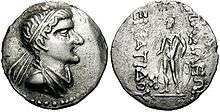Eucratides II
Eucratides II or Eukratides II (Greek: Εὐκρατίδης Β΄) was a Greco-Bactrian king who was a successor and probably a son of Eucratides I. It seems likely that Eucratides II ruled for a relatively short time after the murder of his namesake, until he was dethroned in the dynastic civil war caused by the same murder:
- "As Eucratides returned from India, he was killed on the way back by his son, whom he had associated to his rule, and who, without hiding his patricide, as if he didn't kill a father but an enemy, ran with his chariot over the blood of his father, and ordered the corpse to be left without a sepulture" Justin XLI,6 [1]

Eucratides II as a young man.

Eucratides II

Eukratides II, imitation, possibly Sogdian.
During his earlier years, Eucratides II may have been a co-regent of his father: on his later coins he adds the title Soter (Saviour), which could be an indication that he now ruled in his own right.
Soon after Eucratides' II death, the last Bactrian king Heliocles I (probably another member of the same dynasty) was defeated by the Yuezhi tribes, who expelled the Greek kings from Bactria.
See also
References
- The Shape of Ancient Thought. Comparative studies in Greek and Indian Philosophies by Thomas McEvilley (Allworth Press and the School of Visual Arts, 2002) ISBN 1-58115-203-5
- Buddhism in Central Asia by B. N. Puri (Motilal Banarsidass Pub, January 1, 2000) ISBN 81-208-0372-8
- The Greeks in Bactria and India by W.W. Tarn, Cambridge University Press.
External links
| Preceded by Eucratides I |
Greco-Bactrian King (in Eastern Bactria) 145 – 140 BCE |
Succeeded by Heliocles I |
- O. Bopearachchi, "Monnaies gréco-bactriennes et indo-grecques, Catalogue raisonné", Bibliothèque Nationale, Paris, 1991, p.453
- Quintanilla, Sonya Rhie (2 April 2019). "History of Early Stone Sculpture at Mathura: Ca. 150 BCE - 100 CE". BRILL – via Google Books.
This article is issued from Wikipedia. The text is licensed under Creative Commons - Attribution - Sharealike. Additional terms may apply for the media files.